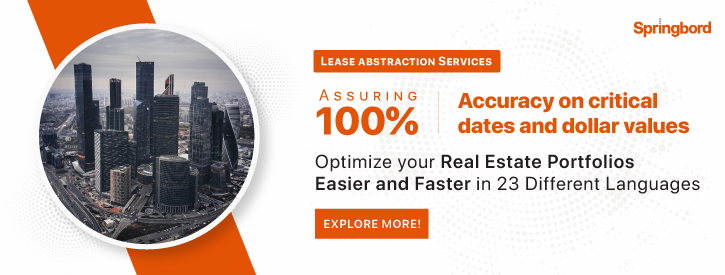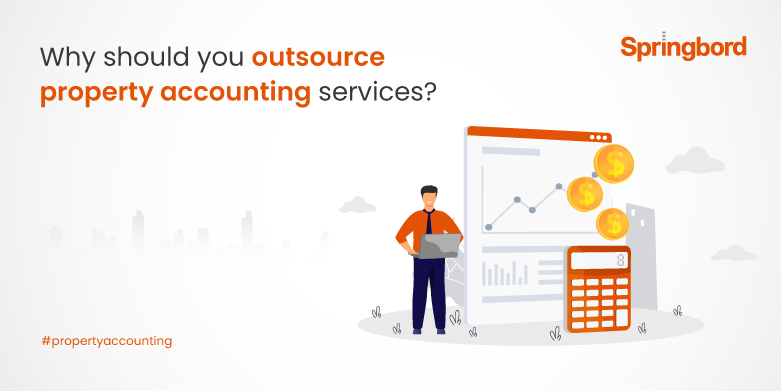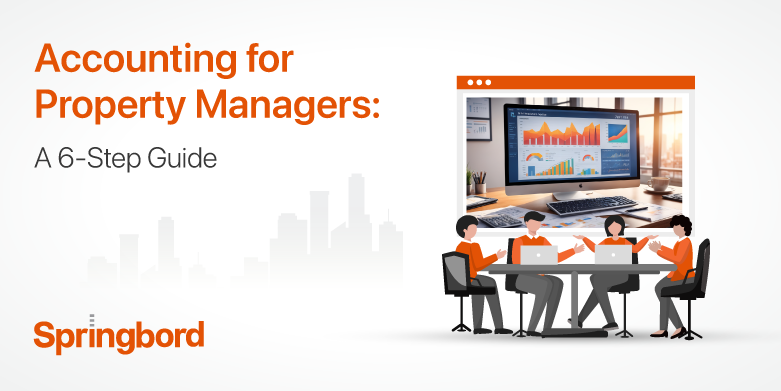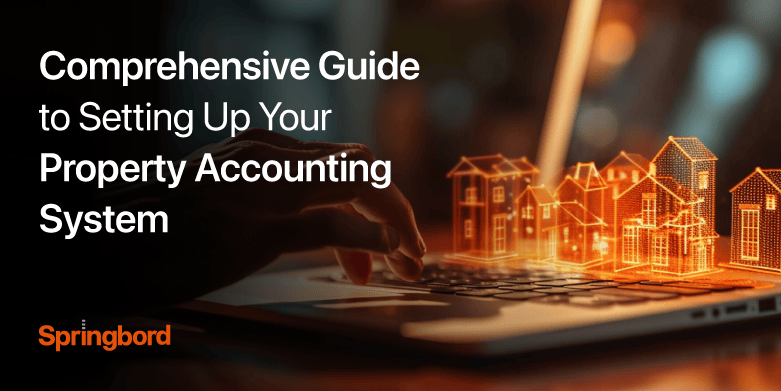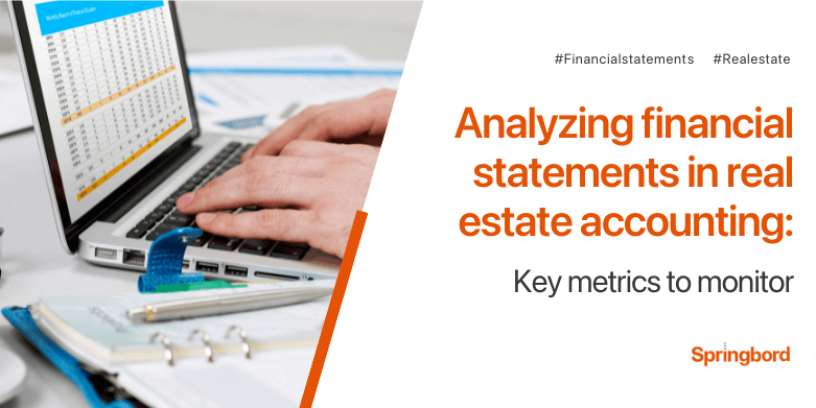 Read time 5 min
Read time 5 minAnalyzing financial statements in real estate isn’t just about crunching numbers—it’s about gaining a deeper understanding of your assets, liabilities, and overall financial health.
For business owners in the real estate sector, mastering key financial metrics is essential for making informed decisions that drive profitability and long-term growth. We will go over the important metrics in this blog to help you manage the complexities of real estate accounting and make the most of your investments.
The importance of financial statement analysis cannot be overstated in the highly competitive real estate market, where strategic choices have the potential to make or break a company. A company’s financial health is fully revealed through its financial statements, which also offer priceless information about its assets, liabilities, revenues, and expenses.
For real estate professionals, these documents are not just formalities; they are essential tools that inform critical decisions such as property acquisitions, portfolio management, and financial planning.
Why Financial Statements Are Critical for Informed Decision-Making in Real Estate
Real estate investments involve significant financial commitments, and the stakes are high. Financial statements reveal the true financial position of a real estate business, helping stakeholders assess whether a property or portfolio is generating the expected returns or if adjustments are needed.
By analyzing key financial metrics such as profitability, liquidity, and efficiency, investors can identify trends, uncover potential risks, and capitalize on opportunities.
For example, the ability to analyze the balance sheet allows investors to assess the value of a property relative to its debt, a critical factor in determining the sustainability of an investment.
Similarly, understanding the cash flow statement is essential for evaluating whether a real estate project can generate sufficient cash to cover operating expenses and service debt, a key indicator of long-term financial health.
Key Metrics to Monitor in Real Estate Accounting
When assessing a property’s performance and potential in the real estate market, financial metrics are essential tools.
Below, we dive into seven essential metrics that every real estate professional should monitor.
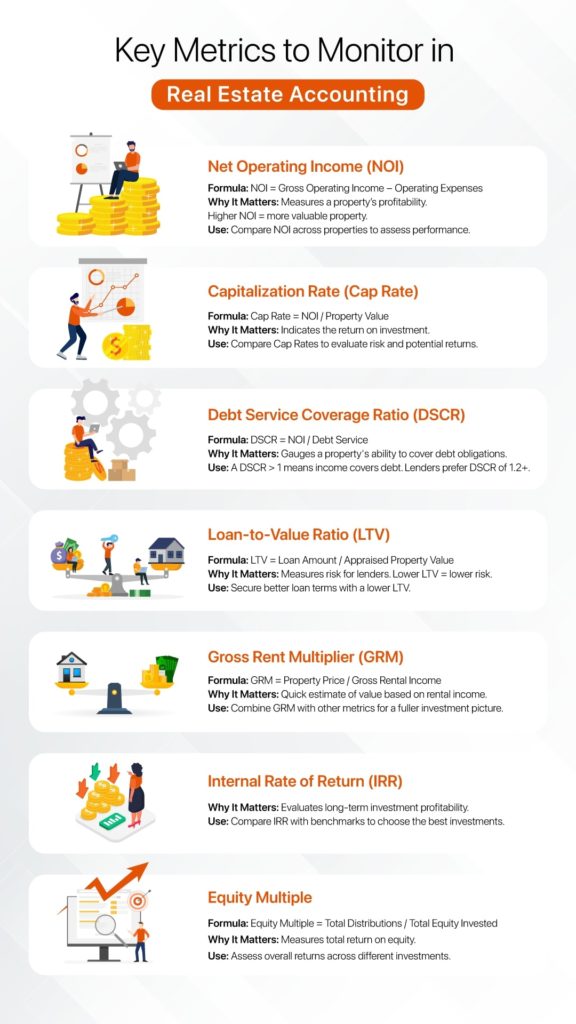
These metrics help investors and business owners make informed decisions. For tailored guidance, consider Springbord’s real estate accounting services.
1. Net Operating Income (NOI)
One important indicator of a property’s profitability is NOI. It is calculated by subtracting all operating expenses, excluding taxes and interest, from total revenue. The formula is:
NOI= Gross Operating Income − Operating Expenses
Significance in Determining Property Profitability:
NOI is important because it provides a clear picture of the income a property generates after covering its operating costs. One of the most important factors in property valuation is NOI, which rises with profitability.
Comparison with Similar Properties:
To assess a property’s performance, compare its NOI with similar properties in the area. This comparison helps identify whether a property is underperforming or exceeding market expectations, guiding investment decisions.
2. Cap Rate (Capitalization Rate)
The NOI is divided by the property’s current market value to determine the cap rate:
Cap Rate = NOI / Property Value
Reflecting Market Conditions and Investment Risk:
Cap Rate is an indicator of the return on investment expected from a property. A lower Cap Rate generally suggests lower risk and a stable market, while a higher Cap Rate might indicate higher risk or a less desirable market.
Comparing Real Estate Investments:
Investors use Cap Rate to compare potential real estate investments. By evaluating Cap Rates across different properties, investors can determine which offers the best risk-adjusted returns.
3. Debt Service Coverage Ratio (DSCR)
DSCR is a measure of a property’s ability to cover its debt obligations. It is calculated as:
DSCR = NOI / Debt Service
A DSCR greater than 1 indicates that the property generates sufficient income to cover its debt payments, which is essential for securing financing.
Importance in Evaluating Debt Obligations:
Lenders closely scrutinize DSCR to assess the risk of lending. A DSCR of 1.2 or higher is typically considered acceptable, as it shows the property has a cushion to handle fluctuations in income or expenses.
Thresholds in Different Market Conditions:
In a volatile market, a higher DSCR may be required to mitigate risk, while in a stable market, lenders might accept a lower DSCR.
4. Loan-to-Value Ratio (LTV)
The ratio of a loan to the cost of an acquired asset is known as the loan-to-value ratio, or LTV. It is calculated as:
Loan Amount / Appraised Property Value is the LTV.
A lower LTV indicates less risk for lenders, often resulting in more favorable loan terms.
Effect on Risk Assessment:
When evaluating a loan’s risk, LTV is a crucial component. A high LTV ratio indicates higher risk, as the borrower has less equity in the property.
Strategic Considerations:
Investors can optimize their financing by strategically managing the LTV ratio, ensuring they secure loans under the most favourable conditions possible.
5. Gross Rent Multiplier (GRM)
GRM is computed by dividing the gross annual rental income (GRM) by the price of the property:
GRM=Property Price / Gross Rental Income
GRM provides a quick estimate of a property’s value relative to its income potential.
Limitations and Use with Other Metrics:
While GRM is useful for quick comparisons, it does not account for operating expenses, making it less precise than other metrics like Cap Rate or NOI.
Comparing Investment Opportunities:
Investors often use GRM in conjunction with other metrics to get a comprehensive view of a property’s value and potential.
6. Internal Rate of Return (IRR)
Role in Assessing Long-Term Profitability:
IRR is a measure of the profitability of an investment over time. It considers the time value of money, making it a key metric for evaluating long-term real estate investments.
Calculation and Interpretation:
IRR is the discount rate at which the net present value (NPV) of all cash flows from an investment equals zero. A higher IRR indicates a more profitable investment.
Comparing with Market Benchmarks:
Investors compare IRR across different investments and against market benchmarks to identify the most lucrative opportunities.
7. Equity Multiple
The total return on investment concerning the equity invested is measured by the equity multiple. It is calculated as:
Total Distributions / Total Equity Invested Equals the Equity Multiple.
Importance in Evaluating Total Returns:
Unlike IRR, which focuses on the time value of money, Equity Multiple provides a straightforward measure of how much money an investment returns in total.
Using Equity Multiple to Compare Investments:
By comparing the Equity Multiple of different investments, investors can assess which opportunities are likely to yield the best overall returns.
Springbord’s expertise in real estate financial analysis ensures that our clients have access to accurate, actionable insights. We use these key metrics to help you optimize your real estate portfolio, maximize returns, and mitigate risks.
Conclusion
Mastering financial statement analysis is crucial in real estate, where understanding these metrics can significantly impact your investment decisions. These metrics provide the insights needed to optimize portfolios, manage risks, and achieve long-term growth.
Take your real estate investments to the next level with Springbord’s expert financial analysis. Let us help you turn your numbers into smart decisions that boost your portfolio. Get started with us today.
If you’re ready to enhance your financial decision-making and take your real estate investments to the next level, don’t hesitate to reach out. Contact us today to learn how Springbord’s expert financial analysis can help you turn insights into impactful strategies.



